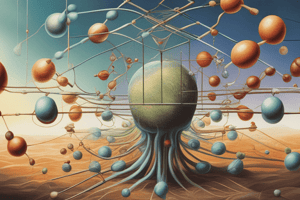Podcast
Questions and Answers
Who assumed that the atom is indivisible?
Who assumed that the atom is indivisible?
- John Dalton (correct)
- E. Rutherford
- E. Goldstein
- J.J. Thomson
What did E. Goldstein discover in 1866?
What did E. Goldstein discover in 1866?
- Presence of canal rays (correct)
- Presence of electrons
- Presence of protons
- Presence of neutrons
What led to the discovery of the sub-atomic particle called proton?
What led to the discovery of the sub-atomic particle called proton?
- Negatively charged canal rays
- Positively charged canal rays (correct)
- Neutral canal rays
- X-rays
Study Notes
The Early Understanding of Atoms
- Ancient Greek philosopher Democritus assumed that the atom is indivisible.
Early Discoveries
- In 1866, E. Goldstein discovered canal rays, also known as anode rays.
The Road to Subatomic Particles
- The discovery of canal rays by E. Goldstein led to the discovery of the subatomic particle called proton.
Studying That Suits You
Use AI to generate personalized quizzes and flashcards to suit your learning preferences.
Description
Test your knowledge of atomic structure and discovery of sub-atomic particles with this quiz. Learn about John Dalton's atomic theory, E. Goldstein's discovery of canal rays, and the identification of the proton.




